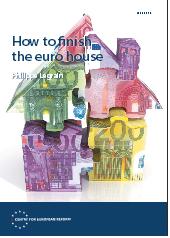Legrain, P. (2014) “How to Finish the Euro House“, Centre for European Reform (CER), June.
The euro is a half-built house whose foundations have been weakened by successive policy mistakes. Battered by a financial hurricane, it has been patched up, altered and extended repeatedly in recent years. Even so, it became so dangerously unstable that it came to the brink of collapse. Finally, in the summer of 2012 the European Central Bank (ECB) stepped in to shore it up. But while the storm has abated for now, the euro remains a ramshackle edifice. Worse, what began as an enlightened experiment in economic cohabitation is becoming a glorified debtors’ prison. How, then, might its architecture be improved and completed?
The immediate crisis in the eurozone does not require major institutional changes. What is needed are bank restructuring and debt write-downs (both public and private), together with policies to support demand while promoting balanced economic adjustment – notably, measures to increase investment and reforms to boost competition (and hence productivity) rather than ‘competitiveness’ through wage restraint. These policies could have been implemented back in 2010 with the prevailing institutional set-up and likewise could be today.
This report focuses instead on how to improve the long-term governance of the eurozone. It addresses four questions. To what extent does the eurozone need common rules, institutions and policies in financial, fiscal, monetary and economic affairs? What should those be? How would eurozone-only institutions interact with EU-wide ones – in particular, what do they mean for Britain? And how should democratic accountability and choice be ensured?
Eurozone governance took a wrong turn during the crisis. The interests of banks in the core of the eurozone were prioritised over those of eurozone citizens. The banks’ risky lending to the eurozone periphery was a principal cause of the crisis but the periphery’s taxpayers – rather than those in the core – are being made to carry the lion’s share of the bill. As a result, the eurozone is now divided between creditor countries – principally Germany – and debtor ones, with EU institutions becoming instruments for creditors to impose their will on debtors. Bailing out Greece’s foreign creditors, thereby breaching the ‘no bail-out’ rule, made German taxpayers feel liable for other member-states’ debts, leading the German government to demand economically inflexible and politically divisive centralisation of fiscal controls in Brussels. The dangers of a highly independent central bank with a deflationary bias that often acts outside its mandate in an openly political manner have also been revealed. Tragically, the crisis has eroded political support for some of the institutional changes needed to make the eurozone work better.
The report argues that while there are a kaleidoscope of potential institutional set-ups for the eurozone and an even greater range of policy settings, only a handful are economically sensible or politically plausible. In effect, there are four possible futures for the eurozone: a Germanic one, a technocratic one, a fiscally federal one and a flexible (or decentralised) one. A fiscally federal eurozone would be best, failing that a flexible one, but for now we are heading towards a Germanic eurozone with a technocratic edge. It is debatable, however, whether this is politically sustainable in the longer term. If not, it might provide the impetus for a fiscally federal eurozone – or provoke its break-up.
The report is structured as follows. It starts by setting out what the aims of eurozone governance ought to be and how they might be achieved. It then sketches out the initial architecture of the eurozone, the flaws that the crisis has revealed, what has changed since then and the current state of play. Third, it outlines five prominent proposals for future reform: the Four Presidents’ Roadmap ‘towards a genuine economic and monetary union’, the European Commission’s Blueprint ‘for a deep and genuine economic and monetary union’, the report by Notre Europe – Jacques Delors Institute’s Padoa Schioppa Group, the Glienicker Group proposal ‘towards a Euro Union’ by leading German scholars and the Eiffel Group proposal ‘for a Euro Community’ by leading French ones. Fourth, it sets out and assesses the four possible models for the future eurozone architecture mentioned in the previous paragraph.
Related posts:
- Lodge, M. & Wegrich, K. (2014) “Bureaucracy may be the solution, rather than the problem, for issues of European governance“, LSE EUROPP, 24 April.
- O‘Neill, J. and Terzi, Al., (2014) “Changing trade patterns, unchanging European and global governance“, Bruegel Think Tank, 25 February.
- Villaverde, J. F., Garikano, L. & Santos, T. (2013) “Did the euro kill governance in the periphery“, VoxEU Organisation, 30 April.




